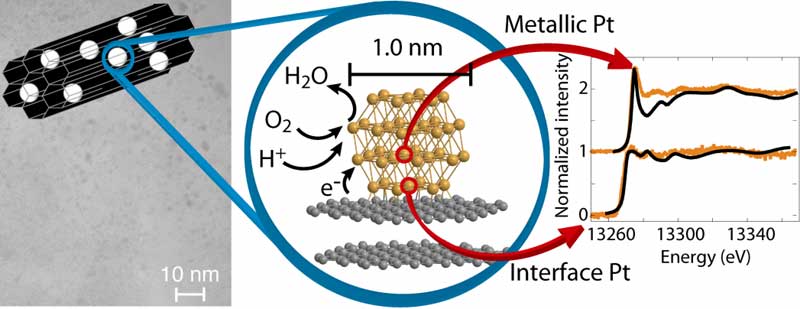Synthesis and Site Structure of a Replica Platinum-Carbon Composite Formed Utilizing Ordered Mesopores of Aluminum-MCM-41 for Catalysis in Fuel Cells |
Kazuki Oka, Yoshiyuki Shibata, Takaomi Itoi, and Yasuo Izumi,
Journal of Physical Chemistry C, 114(2),
1260 - 1267 (2010)![]() [The
PDF file][Supp.Info]
[The
PDF file][Supp.Info]
Platinum nanoparticles have been reported with mean size of between 1.5 and 7 nm supported on carbon. The contact between Pt nanoparticles and C has never been controlled and monitored nanoscopically. In this paper, stable Pt nanoparticles with mean size of 1.2 nm were synthesized embedded on/in C matrix catalytically produced from acetylene over the Pt nanoparticles. The replica-Pt-C composite was synthesized inside the ordered mesopores (2.7 nm) of Al-MCM-41 followed by removal of template. The contact between Pt nanoparticle and C was experimentally observed by high energy-resolution Pt L2-edge XANES spectra tuned to 11065.7 eV, at lower energy by 5 eV than the Pt L beta1 peak top for the replica-Pt-C pressed to electrolyte polymer (Nafion). The spectra were nicely reproduced in theoretical spectrum using ab initio multiple scattering calculations for the interface Pt site between cubo-octahedral Pt38 and graphite layers. Other Pt sites detected in state-selective Pt L2-edge XANES were exclusively metallic for replica-Pt-C/Nafion either in air or in H2. Thus-characterized replica-Pt-C composite was tentatively tested as cathode of H2-air polymer electrolyte fuel cell in comparison to commercial 20 wt% Pt/Vulcan XC-72 as cathode. The improvement of Pt dispersion stabilized on/in C matrix, effective contact of Pt with C, and diffusion of fuel O2 in a few nanometers of replica-Pt-C powder was suggested.

Chiba University > Graduate School of Science > Department of Chemistry > Dr. Yasuo Izumi Group